If I told you winter was the best time of the year to be in the desert you’d ask me ‘so what’s new?’ Or ‘how predictable is that?’ Then, think about it, do we really? I mean if not exactly make a beeline, at least make serious plans to hit the desert in winter? From watching the travel patterns of my good friends – compulsive travellers all, and being privy to plans of family – who I believe must be genetically bound to the travel bug, I don’t see many of them hitting the arid zones this time of the year. The closest some have been is Jaipur but then that is a Dalrymple baby. Before I come to the biggest reason, literally, you should be hitting the deserts in winter – forts, those mammoth stone-and-earthen glories from which whole cities and cultures flowed, let me not elide the not so imposing ones – you can’t later say that I didn’t enthuse you enough.
Yes, Agra and Jaipur are deserts. Delhi’s Red Fort, Agra Fort and Amer and Nahargarh Forts of Jaipur are as resplendent as they come, I agree. But allow me to push you a little more while out there – towards the magical vastness of windswept dunes, the magnificence of gold crested sand, the soul-stirring, howling emptiness, an unforgiving landscape but one that opens up the most unobstructed views of the night sky dripping stars. Besides getting away from the milling tourists, imagine those frames you can pack – those mesmerising long shadows cast by the winter sun. And I can’t tell you enough how beautiful the sunrise and sunset is in the desert. It definitely is inspiring – I came up with my blog name ‘Wanderink’ while bivouacking in the sands of Jaisalmer. Just imagine what you will come up with.
While this is a clarion call to be desert-bound this winter, this is also about some of my favourite forts from north and central India. Not all of them are in the desert, of course. Most you will also not find in a regular travel itinerary either. I like them for reasons as varied as sheer splendour and history, heartrending aloofness to panoramic views to helping me play myth buster.
Ater Fort
(90 km from Agra near the town of Bhind, by the Chambal River)
Subterranean openings flank the double-arched entrance – possibly sally-ports in the event of an attack or prisoner dungeons. You reach an enceinte which must have been a garden; row after row of exquisitely foliated sandstone pillars lie about scattered. A smaller arched entrance leads to another courtyard where the king would have met his subjects. Here you can see the Diwan-I-Am with the mandatory water body in the front which acted as a sort of security measure. Further on there was the ‘Satmanjila’, a watchtower, from where the guards could keep an eye on the shifting ravines below. I scrambled up several precariously narrow flights of stairs in the donjon which opened to an abacus; the view of the Chambal ravine is splendid from here. The Ater was a marvel, an architectural delight with its labyrinthine walkways and secretive seraglios, moreover it tugged at my heart with its stately aloofness.
Bhangarh Fort
(240 km from Delhi, via Alwar. A worthy detour if heading to Jaipur.)
You walk up a ramp into the fort. Once inside you are surrounded by elaborate courtyards with connecting doorways, ante rooms with sandstone pillars and crumbling walls with niches for idols and bibelots still intact. Dark passageways down stairways lead to grotty, smelly dungeons. Don’t venture down unless you have a torch as some end abruptly at deep-ended buttes. For the Bhangarh in all its ruined glory climb up to the highest rampart. With the massive boulders which once held lofty arches, ornate windowsills and balustrades, from up here it is indeed Acropolis which was also destroyed around the same time. In fact the scale of destruction begs many parallels: Parthenon, the most important building in Acropolis used to store gunpowder during the Sixth Ottoman-Venetian war, was totalled when hit by a cannonball. In Bhangarh too, the obliteration is of cataclysmic dimensions that theories about its decimation revolve around the supernatural.
Junagarh Fort
(Bikaner, 350 km from Jaipur; or 450 from Delhi through the famed Shekhawati region where you can spot a haveli, almost a miniature fort, at every turn.)
One late afternoon, I wrote in an earlier post, I emerged from Junagarh Fort the city of Bikaner radiating in all directions convinced why it was my favourite fort in the country.
- There was no out-of-the-blue cordoning off of areas with the unsettling ‘The royal family still lives here’ excuse.
- This was not a ‘living fort’ – and by extension undergarment-splattered ashlars, stinking bathroom nullahs cutting across your path, unyielding milch animals, and static squatters were missing.
- The fort itself was immaculately, passionately, preserved. (My best guess was because the erstwhile ruling family was still pretty much active in its preservation – and not given over to any government organisation.)
- The audio guide was quite comprehensive as it was exhaustive – the best I ever laid my ears on. (There was no need for a deposit even – neither money nor your travel documents!)
- The eateries were right by the exit – just where I wanted them. And when.
- Lastly but mostly the absence of severe ‘No Photography’ signs in the fabulously stacked armoury museum.
Jahangir Mahal
(In ‘cenotaph wonderland’ Orchha – usually given the miss between the awe-inspiring stupas and forts of Gwalior and the heritage marvel that is Khajuraho.)
The Ganesh Darwaja – a gigantic arched gateway with a bulbous dome and ornate embellishments on the spandrel – ushers you into Orchha town with a regal flourish. The Jahangir and Raja Mahals, set within a large quadrangle, are the biggest attractions of Orchha. To reach the fort complex, you pass through a bridge with government offices on one side and eateries on the other. The Ram Raja Restaurant here serves not-so-good pizza but quite-good milk shakes. The Jahangir Palace, built during the 17th century by Raja Bir Singh Deo, is an amalgamation of Hindu and Mughal architectural styles. Story goes that Bir Singh and Prince Salim (before he became Emperor Jahangir) were great friends and the palace was renamed to honour Jahangir when he was passing through after his coronation. A part of the palace has been fashioned into a heritage hotel but I recommend you give this one a miss for some irenic ones overlooking the Betwa River.


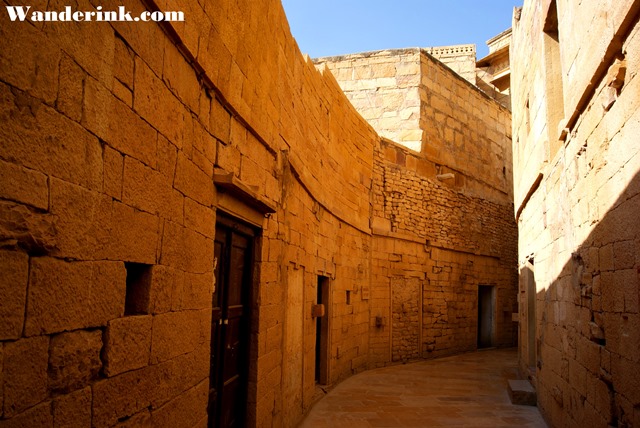
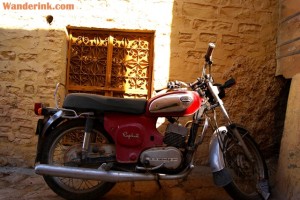
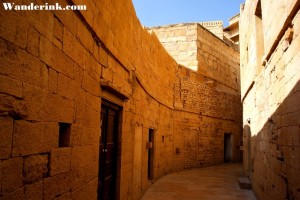
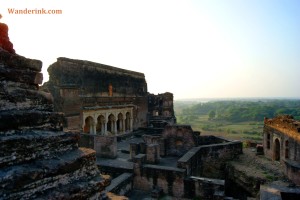
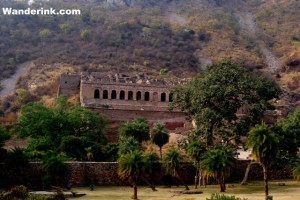
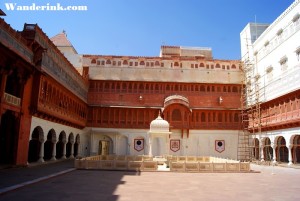
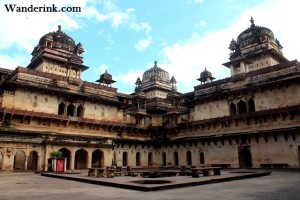









I stayed at the palace hotel and that too in the annex for Nur Jahan’s staff. Even met up with the resident ghost, next time would like to experience Nur Jahan’s tenements and feel a bit worldly wise 🙂
Have to check out Bhangarh, Jungarh, Ater and Bundi too! The ever growing bucket list I am afraid, tsk, tsk!
The resident ghost? You gotta tell me about it. Bhangarh doesn’t have any, btw.